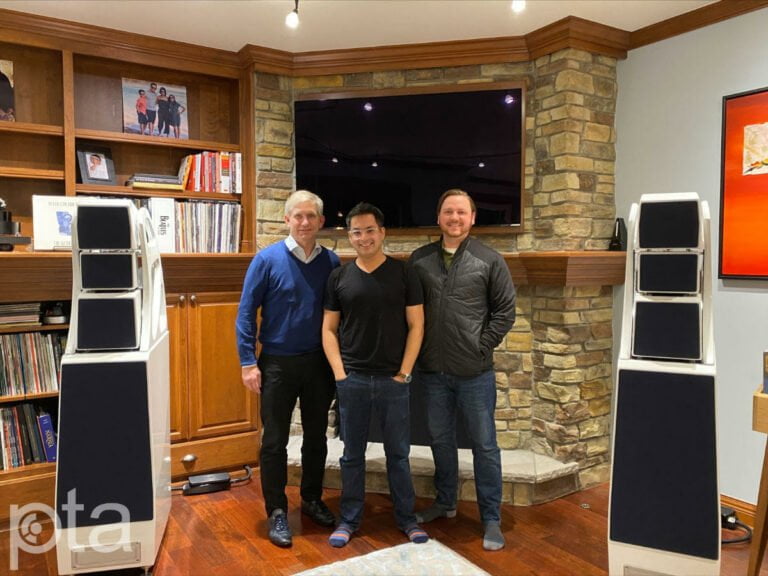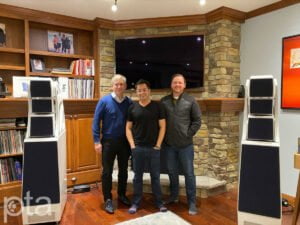
Has the new Wilson Audio Alexx V (website) loudspeaker caught your interest? Are you interested in the most in-depth review available? Experience our journey with the Alexx V…
The Wilson WAMM Master Chronosonic or Chronosonic XVX loudspeaker driven by the D’Agostino Relentless amplifier can be intoxicating but out of reach for most, including myself. Although out of reach, the DNA of these references trickles down the line. I was intrigued to see so much DNA from the WAMM and XVX work their way into the new Wilson Alexx V Loudspeaker.
Words and Photos by Mohammed Samji
Could the new Alexx V loudspeaker be an order of magnitude better than my trusted Alexia Series-2 loudspeakers? Could they work in a small room with a corner setup like mine?
Wilson Audio Alexx V Loudspeaker History
To understand the Wilson Alexx series, we need to go back in time. Following the WAMM Series 7, David Wilson developed the X1/Grand SLAMM loudspeaker in 1993.
The introduction of the Grand SLAMM created a gap between the legendary Watt Puppy loudspeaker and the Grand SLAMM series. A new speaker was started and code-named Bull Dog to fill this void and would be released as the MAXX in 1998. The MAXX Series-2 would follow in 2004, and the MAXX Series-3 in 2008.
Daryl Wilson led the follow-on speaker to MAXX Series-3 while David Wilson was developing the WAMM Master Chronosonic. The co-development of these side-by-side allowed R&D learnings from the WAMM to be leveraged in the MAXX replacement.
The result was the introduction of the original Alexx Loudspeaker in 2016 that would now use two different-sized midrange speakers, the ability to adjust all modules for time alignment, and the incorporation of Wilson proprietary X-Material. The two Xs in the Alexx name pay homage to its predecessor, the MAXX Series-3.
Fast forward five years and the replacement to the Alexx Series-1 arrives with the new Alexx V loudspeaker. Why did they go from Alexx Series-1 to Alexx V? I thought I had it figured out and that V was code for 5 (Maxx 1, 2, 3, Alexx 1, Alexx 2), but that is just a coincidence. Daryl explained that V refers to its usage of Wilson’s proprietary V Material that was first used in the Chronosonic XVX. There are also two XXs in Alexx, and the combination of Alexx V is an homage to a smaller XVX.
The Alexx V is born. Enough history….
Wilson Audio Alexx V Manufacturing
Construction of the Alexx V is performed start-to-finish at the Wilson Audio manufacturing facility in Provo, Utah.
I’ve documented the process previously for the Alexia Series-2 here. The process for the Alexx is generally the same, but it takes more time to manufacture the more complex design and additional modules.
Daryl Wilson explained:
“The hands-on time here at Wilson Audio to craft a pair of Alexx V is roughly 130 hours. This does not consider the five days’ dry time needed for our adhesives and the additional 4-7 days’ dry time necessary for the paint & clear coat to cure. Nor does this 130 hour take into consideration the time it takes our partners to manufacture the intricate metal elements found in the Alexx V design and the finishing processes before delivering to Wilson Audio.“
The factory was kind enough to provide pictures of my pair working through the process. You can view their journey here.
Lots of love goes into every step…
And the final steps in the process can be seen here:
Wilson Audio Alexx V – What’s New
New 3D-Printed Convergent Synergy Carbon Tweeter
The Wilson Synergy Mach 5 has been the reference tweeter since the release of the WAMM. One of the critical differences in the Mach 5 version is that it experimented with the durometer of the enclosure material and made it softer.
To come up with something better, Wilson shifted to leveraging 3D Printing to allow for rapid prototyping. While many materials they tried didn’t pan out, they discovered a carbon fiber strand + a specific 3D printer that had the potential to mix things up.
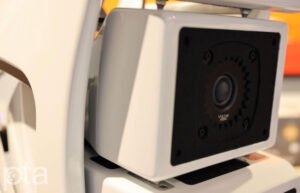
This resulted in the birth of the Convergence Synergy Carbon Tweeter. Wilson claims, “The CSC Tweeter offers far greater and more linear high-frequency extension while providing unprecedented ambient retrieval and superior harmonic detail.”
Each carbon tweeter uses 1,509 inches of carbon to print one tweeter enclosure. The Alexx V is the first loudspeaker to ship with this, but I think it’s fair to assume we will see it appear in more places.
The Addition of V-Material
Wilson’s proprietary V-Material is the new cool kid at Wilson. It was first introduced in XVX and used in the Wilson Audio Pedestal. I asked Daryl to give me the elevator pitch on V-Material. He explained:
“V-Material is an advanced iteration of our X-Material that is masterfully designed for vibration absorption and dissipation. It has many structural characteristics of X-Material, but its unique damping properties were refined and enhanced for particular applications. To date, V-Material is far superior to any other structural material we have tested in vibration mitigation.”
In a Wilson Audio Alexx V, V-Material is incorporated into the cross brace, at the top of the woofer cabinet, and in the upper gantry. V-Material is also used in the new acoustic-diode feet, but more later.
Alexx V Time-Alignment
Time alignment is one of the critical tenants of Wilson’s design. The goal is to ensure that sound from each driver arrives at your ear in your listening position simultaneously down to a few microseconds.
The updated hardware improvements were taken from the XVX to allow for additional precision in the time domain. I asked Daryl to shed some color on the differences across the line. Daryl explained:
“We have long stated the accurate and precise reproduction of music, especially in micro detail, dynamic contrast, and correct tonality of musical instruments depends on the loudspeaker’s ability to be carefully aligned in the time domain.
The Alexia 2 has twice the number of tweeter module increments and so alignment from Alexia 1 (15 microseconds accuracy) to the Alexia 2 (10 microseconds accuracy).
Alexx V’s design has been more refined in many ways. One of those refinements was the individual module baffle alignment with the listener in every installation configuration. This brought the time alignment accuracy from 10 microseconds to 8 microseconds.
The Chronosonic XVX and WAMM Master Chronosonic utilize the micrometer hardware, which provides time alignment down to an incredible 2 microseconds.”
Alexx V Upper Gantry
All this fancy hardware and precise alignment of the upper modules are housed in a new upper gantry. It’s gorgeous and has an open design like the XVX and WAMM. It makes the speaker feel smaller and allows you to see the intricate details. The prior solid sides feel heavy visually compared to this open gantry.
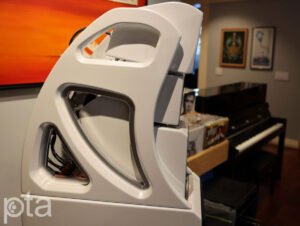
Wilson provides grills for the sides of the gantry; I recommend you look at them for two seconds, test out the cool integrated magnets that allow you to put them in and out, and then toss them back into the crates for long-term storage. The speakers sound better when removed.
Lastly, the new gantry provides an integrated rechargeable light. It looks beautiful and is helpful during setup.
QuadraMag 7″ Midrange driver
The new 7″ QuadraMag midrange driver is made from aluminum, nickel, and cobalt with five separate magnets. This driver is also used in the XVX. 
I asked Daryl for any additional color on the QuadraMag Driver:
“One of Dave Wilson’s last projects was exploring and refining what would eventually be called the QuadraMag. This extremely musical 7” mid-range exquisitely reproduces subtle textures and space in such a satisfying and realistic way. The project was only about 40% complete when Dave passed. The challenge with using this AlNiCo design is the low sensitivity. We are very pleased with the sonic results with several modifications and careful crossover blending. Vern Credille and Daryl Wilson finished refining this mid-range just in time to be effectively implemented in the Chronosonic XVX. The Alexx V is currently the only product to incorporate the QuadraMag into its upper modules array.”
The upper 5.25″ midrange driver is the same midrange driver that debuted in the original Alexx Series-1 and was used in the TuneTot and SabrinaX.
Behind each of the midrange drivers are changes to internal bracing + the addition of inner wave diffusers integrated to further aid resolution. I assume these are very similar to the work done on the Alexia Series-2 and other modern Wilson offerings.
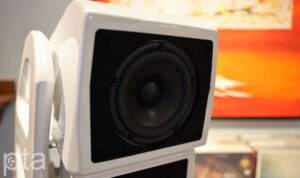
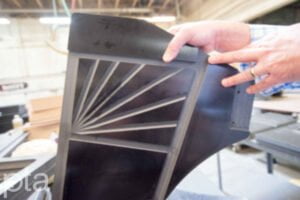
Acoustic Diode Feet
I have tried various feet under my Wilson Speakers over the years with varied success, with most attempts being unsuccessful. I did like the Stillpoints Ultra 5 feet under my Alexia Series-1, but they were awful under my Alexia Series-2. In general, the stock feet work best since that was what the speaker designer voiced the speaker with.
Wilson has taken the learnings from their Wilson Pedestal Feet and incorporated them into their new Acoustic Diode Footer.
Daryl explained that the development of the pedestal informed them about mixed material and vibration control. The Wilson Pedestal is designed to decouple and isolate the device it rests on. In the current design, a Wilson Pedestal might have some micro-movement, and for source components and amplifiers, this will have no impact.
On the other hand, a loudspeaker needs a stationary baffle to launch the signal. You would not want it to move as it will smear what you hear. Daryl explained that you need something that provides isolation but also keeps the speaker stationary and not floating. This is one of the key differences between the Pedestal and the Acoustic Diode.
The Acoustic Diode provides a V Material buffer between vibration from the floor to the speaker and from the speaker down to the floor while maintaining solidity in its position and preventing any smearing or shifts to tonality.
These Acoustic Diodes first shipped in the Alexx V but are now standard on the XVX and WAMM. These feet can be purchased from Wilson to be used on any of their loudspeakers.
Woofers
The thunderous low frequency is courtesy of 10.5” and 12.5” woofers that work in conjunction. These are the same drivers used in the XVX and WAMM.
AudioCap WA Capacitors
Wilson now produces Capacitors in-house with extremely tight tolerances. These are used throughout the Alexx V.
Wilson Audio Alexx V – Arrival and Unpacking
The Wilson Alexx V shipped in 3 huge crates with a combined shipping weight of 1400 pounds. The speakers are 500 pounds per side once set up.
During delivery, the delivery driver wanted to know if I was running a business and what shipped in these heavy crates. I explained they were a pair of speakers. He then asked me, “Are they better than Bose?” I replied yes, signed the release form, handed him a tip, and just smiled to myself.
The crates are enormous and require two people to move. The lower cabinet crates are large enough that I can fit into them.
Looking into the crates, we see the upper modules perfectly packed.
One tip, the speakers are hefty, and you risk damaging any flooring even with the supplied castors. I lined my floor with RAM board from Home Depot to prevent any damage. It made the process easy, and my floors walked away with no scuffs.
Once into the room, marvel at the detail of the gantry. Soak it in since, once assembled, you won’t be able to appreciate all the little details.
All the various hardware, acoustic diode feet, essential tools, and the mammoth Wilson Jack are included.
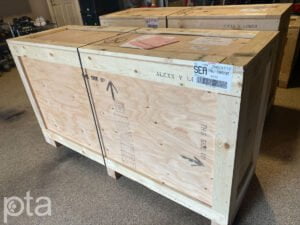
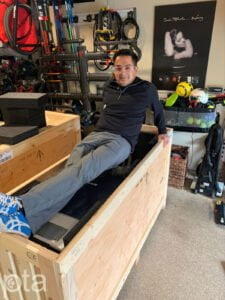
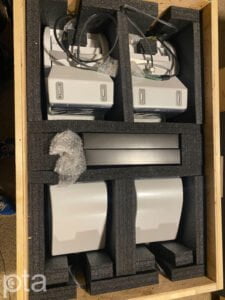
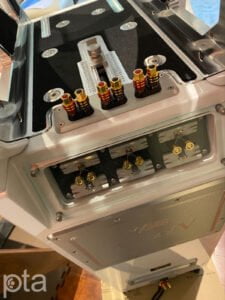
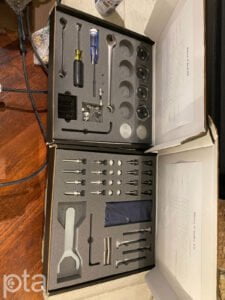
Wilson Audio Alexx V Installation
We started by placing the Alexx V in the exact location where my Alexia Series-2 had been located. All the upper modules were carefully installed using a starting distance to my listening position.
Even though it makes no audible difference, I recommend you pay homage to David Wilson and place the odd serial number loudspeaker on the left and the even on the right as you drop the speakers into your room. This is the standard Wilson setup procedure.
Bill Peugh from Wilson spent over an hour understanding the room and my corner setup before a speaker was moved. At this point, the process starts. The space was mapped, and the Wilson Audio Set-Up Procedure (aka WASP) was completed. This takes time, but all efforts here will be rewarded. I can’t stress enough that have a dealer perform the setup. It is included in the price!
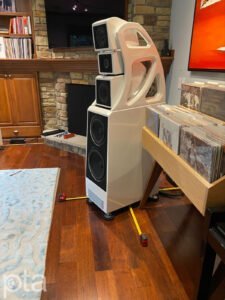
In the final hours, we moved the speakers’ fractions of an inch to get the placement perfect. Once the procedure was complete, the speakers were 79 inches apart and 129 inches from my listening position. The speakers moved further apart and more into the room compared to the prior Alexia Series-2 installation.
Huge thank you to Gary Bruestle of Definitive Audio, Bill Peugh, and Tyler Hall of Wilson for the hours they spent getting the placement. And a special thank you to John Smith for helping me re-pack my Alexia Series-2 back in its crates and get the Alexx V into our home.
Alexx V – Fine Tuning Tips
Cable management can impact performance. Here is what I found sounds best. First, keep everything tidy. A black brace allows you to keep all three sets of wires separated from the upper modules.
The most important thing is this: do not use the airtight gasket to stuff cable slack into any of the modules. Instead, pull all the slack out, push one inch back, and re-tighten the airtight gasket on the back of each upper module. The modules sound much better without cable slack stuffed in them. When this is done correctly, the difference on the 7″ midrange is not subtle.
Here is the last cable tip (…maybe I am going crazy). When you pull all the slack out, the connection cable from the tweeter module will be extended. Since it is long, encourage it to touch the cross brace filled with V-Material. To my ears, things sounded a little better when the tweeter cable was touching the V-Material brace. The change was small, but the background got even quieter.
The Wilson Audio Alexx V, at 500 pounds per side, may settle into your floor and require a final re-level after a few hours. It is evident on mine after a few hours as they settled into the floor, and leveling was done a second time after all other positioning was complete.
Wilson Audio Alexx V Listening
After living and, more accurately, loving my Alexia’s for over ten years, I knew I was in for a treat with the Alexx V swap. But realistically, how much better could it get? Before pressing play on critical listening post set up, I was expecting a bigger soundstage, more low-frequency texture, more of the recording venue to come through, similar to what we saw when I had two Wilson WATCH Dog subwoofers, and the usual improvements in tonality.
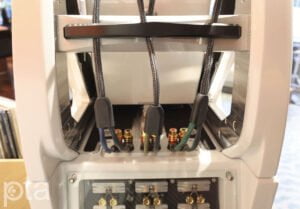
On the first play, yes, so much of that happened. The low-frequency texture and bloom, especially around the human voice, brought me to tears. But I didn’t expect the overwhelming level of resolution to be uncovered. I’m super blessed to have had a system that was already highly resolving, but the new resolution I was hearing surprised me in a very good way.
More impressive is that this new resolution was present at both ends of the SPL spectrum. Playing the Alexx V loud, like I love, demonstrated the Alexx V’s ability to uncover and continue to deliver micro-details at extremely high SPLs even after that slam of a transient! On the other end, the Alexx is quieter than any speaker I have auditioned, allowing it to deliver resolution on a pitch-black background even when the speaker is played soft. I found myself turning the volume down in my room since this experience was intoxicating, especially with the human voice.
Let’s review a few recordings that demonstrate what I was hearing:
Meg Meyers, “Running Up That Hill”
Pressing play on “Running Up That Hill” almost knocked me out of my listening seat. It was a perfect example of what was different with the Alexx V… the sheer amount of detail and air being resolved on the synthesizer & Meg Myers’s voice left me gobsmacked. I froze…the goosebumps were instantaneous, something I hadn’t had with that track in my room in the past. I had the same viral reaction when this track was played at a low or insanely high volume.
Sting, “Rushing Water”
I’ve been nicely surprised by Sting’s new album, The Bridge. Its sound is fresh in my memory; we’d had the opportunity to hear Sting play it live at the Colosseum at Cesar’s Palace. It was the first live show we’d seen during COVID times, so it is one that I won’t forget.
The Alexx V presented a vast sound stage with precise placement of all elements. The drums were fast and tight, tonally perfect, with the right texture and decay. Sting’s voice rides on top of the rhythm section, and all-up reproduction took me back to the Colosseum.
Ben Harper, “Amen Omen”
“Amen Omen” is one of my favorite Harper tracks. It’s an acid test for tonality for me when I change something in my room. Hitting play revealed perfection in tonality emanating from the Alexx V but also flexed the Alexx’s ability to reveal a little more detail on the edge of Harper’s voice and the cymbals and quieter sounds in the track. By far the best reproduction I have heard of that track to date in my room or any room where I have played this.
While listening, I stepped out of the room and walked to my office to grab some more paper. Interestingly, the music that spilled out of my listening room still sounded sweet as I walked down the hallway.
Dixie Chicks, “Landslide”
Ok, I’m a sucker for anything from Fleetwood Mac, and this cover of “Landslide” makes you smile. Two seconds after you hit play, the detail and tonality of their voices make you smile. If you don’t get goosebumps from the reproduction of this coming through the Alexx, then that’s just wrong.
Beyonce, “Partition”
This Beyonce track should light up a room to demonstrate Wilson’s low-frequency muscle. The low frequency and texture of the bass guitar were explosive, fast, and beautifully textured. The room pressurized instantly, and the low octaves were elevated significantly compared to my prior experience with the Alexia Series-2 paired with 2 WATCH Dog subwoofers. If you listen to this track, listen to the finish; halfway through, there is a transition with a jet-black background before it takes off again.
Chris Stapleton, “Death Row”
If you could listen to just one track on the Alexx V, I’d choose this Chris Stapleton track. It brings together all of what I am hearing in the new speaker, expressed in the incredible tonality and midrange as you hear Stapleton sing from the heart in this chest. Gobs of detail across this voice and the instruments take you to that moment when it was recorded. This is produced with a large soundstage, precise placement, and dynamics and texture. Some speakers do some of these things, but it’s rare to see all of this simultaneously.
Listening and Wilson Grills
Now in terms of the grills.
With my Alexia Series-2 Loudspeakers, I didn’t find a vast improvement with the grills on or off. Yes, it was better off, but not enough that I missed it when I put them back on.
It’s a different story with the Alexx V. With the added resolution; the difference is not subtle when the grills are removed. Wilson explained that the grills attenuate the signal by about 1dB between 2 and 4khz. On the Alexx V, this is very easy to hear. I recommend leaving them off and enjoying the design’s beauty.
Wilson Audio Alexx V Summary
When I embarked on trying the Alexx V in my room, I knew I was in for something special. Every upgrade in the past has shown improvements as Wilson has benefited from all of its R&D investments.
As a culmination product, the Alexx V was more than a mere additive sum. I would go as far as to describe it as a step-function improvement over my prior Alexia Series-2. Every aspect I cherish as I listen to my favorite recordings got better…cue all those words reviewers like to drop here.
If I had to pick just two of Alexx’s standout achievements, they can reproduce micro-details at any volume and then paint them over a pitch-black background. Holy moly. There is a deftness and a delicacy that is both unexpected and delightful for a speaker that stands almost six feet tall and weighs over 500 pounds.
While wrapping up the review, I had a friend over who was a concert pianist. I played for him a favorite acoustic track of John Legend that I love. In the end, he looked at me and said, “Wow, that sounds like the grand piano I have at home! I’ve never heard it reproduced like that.” I could only nod.
For me, this hobby has one goal: travel across time and space. Take me to the moment and to the place where that music was first created. Take me there, and leave me. The Wilson Audio Alexx V has brought me closer to that ideal than I ever have gotten before. Of all the gin joints in all the towns worldwide, the Alexx V walked into mine. All I can say now is that they will be hard to beat. In the meantime, all I know is that I’m going to have a lot of fun.
Give them a listen if you dare. I’m betting you won’t regret it. Just be sure to bring some Kleenex because your poor checkbook will need sympathy. Sorry about that.
And yes, I purchased the review sample.
-Mohammed
Wilson Audio Alexx V price: $135,000/pair with standard finishes, $138,000/pair for special finishes, and $151,000/pair with a premium pearl finish.
Associated Components
- Dan D’Agostino Momentum Phono Pre-amplifier
- Dan D’Agostino Momentum HD Pre-Amplifier
- Dan D’Agostino Momentum S250 Amplifier
- dCS Vivaldi DAC, Master Clock & Up sampler
- AMG Viella Forte Turntable with two AMG 12JT Turbo Arms
- Lyra Atlas Lambda SL & Lyra Atlas Lambda Mono cartridges
- HRS M3X Isolation Bases, nimbus couplers, and damping plates
- Wilson Audio Pedestals (under all sources and amplifiers)
- Transparent Audio Opus and Magnum Opus Gen 6 Interconnect Cables
- Transparent Audio Gen 5 Reference XL Speaker Cable
- Transparent Audio Opus Gen 6 Balanced Phono cable (Atlas SL)
- AnalogMagik Balanced Phono cable (Atlas Mono)
- AudioQuest Niagara 7000 Power Conditioner
- AudioQuest Dragon Power cables
- AudioQuest Ethernet & HDMI cables
- Nordost QKore 1 & 3 grounding blocks
- Synergistic Research HFTs in various locations around the room
- Emotiva RMC-1L Surround Processor
https://parttimeaudiophile.com/2022/01/21/wilson-audio-alexx-v-review



